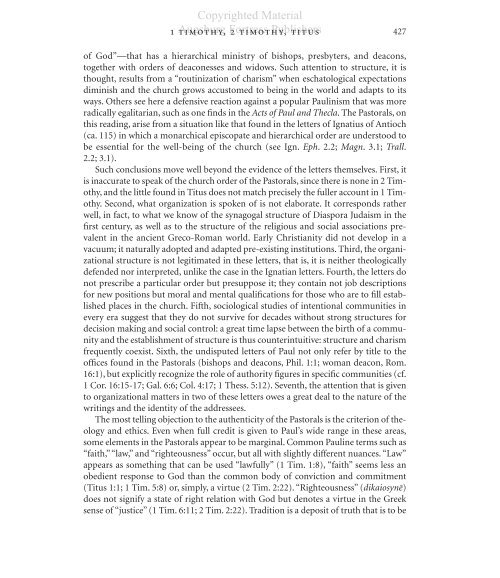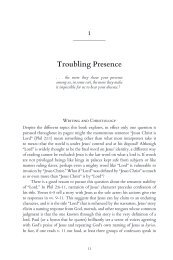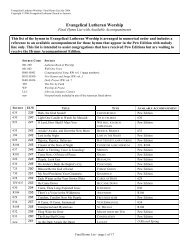19. Pastoral Letters: 1 Timothy, 2 Timothy, Titus - Augsburg Fortress
19. Pastoral Letters: 1 Timothy, 2 Timothy, Titus - Augsburg Fortress
19. Pastoral Letters: 1 Timothy, 2 Timothy, Titus - Augsburg Fortress
Create successful ePaper yourself
Turn your PDF publications into a flip-book with our unique Google optimized e-Paper software.
Copyrighted Material<br />
<strong>Augsburg</strong> <strong>Fortress</strong> Publishers<br />
1 timothy, 2 timothy, titus 427<br />
of God”—that has a hierarchical ministry of bishops, presbyters, and deacons,<br />
together with orders of deaconesses and widows. Such attention to structure, it is<br />
thought, results from a “routinization of charism” when eschatological expectations<br />
diminish and the church grows accustomed to being in the world and adapts to its<br />
ways. Others see here a defensive reaction against a popular Paulinism that was more<br />
radically egalitarian, such as one finds in the Acts of Paul and Thecla. The <strong>Pastoral</strong>s, on<br />
this reading, arise from a situation like that found in the letters of Ignatius of Antioch<br />
(ca. 115) in which a monarchical episcopate and hierarchical order are understood to<br />
be essential for the well-being of the church (see Ign. Eph. 2.2; Magn. 3.1; Trall.<br />
2.2; 3.1).<br />
Such conclusions move well beyond the evidence of the letters themselves. First, it<br />
is inaccurate to speak of the church order of the <strong>Pastoral</strong>s, since there is none in 2 <strong>Timothy</strong>,<br />
and the little found in <strong>Titus</strong> does not match precisely the fuller account in 1 <strong>Timothy</strong>.<br />
Second, what organization is spoken of is not elaborate. It corresponds rather<br />
well, in fact, to what we know of the synagogal structure of Diaspora Judaism in the<br />
first century, as well as to the structure of the religious and social associations prevalent<br />
in the ancient Greco-Roman world. Early Christianity did not develop in a<br />
vacuum; it naturally adopted and adapted pre-existing institutions. Third, the organizational<br />
structure is not legitimated in these letters, that is, it is neither theologically<br />
defended nor interpreted, unlike the case in the Ignatian letters. Fourth, the letters do<br />
not prescribe a particular order but presuppose it; they contain not job descriptions<br />
for new positions but moral and mental qualifications for those who are to fill established<br />
places in the church. Fifth, sociological studies of intentional communities in<br />
every era suggest that they do not survive for decades without strong structures for<br />
decision making and social control: a great time lapse between the birth of a community<br />
and the establishment of structure is thus counterintuitive: structure and charism<br />
frequently coexist. Sixth, the undisputed letters of Paul not only refer by title to the<br />
offices found in the <strong>Pastoral</strong>s (bishops and deacons, Phil. 1:1; woman deacon, Rom.<br />
16:1), but explicitly recognize the role of authority figures in specific communities (cf.<br />
1 Cor. 16:15-17; Gal. 6:6; Col. 4:17; 1 Thess. 5:12). Seventh, the attention that is given<br />
to organizational matters in two of these letters owes a great deal to the nature of the<br />
writings and the identity of the addressees.<br />
The most telling objection to the authenticity of the <strong>Pastoral</strong>s is the criterion of theology<br />
and ethics. Even when full credit is given to Paul’s wide range in these areas,<br />
some elements in the <strong>Pastoral</strong>s appear to be marginal. Common Pauline terms such as<br />
“faith,”“law,” and “righteousness” occur, but all with slightly different nuances. “Law”<br />
appears as something that can be used “lawfully” (1 Tim. 1:8), “faith” seems less an<br />
obedient response to God than the common body of conviction and commitment<br />
(<strong>Titus</strong> 1:1; 1 Tim. 5:8) or, simply, a virtue (2 Tim. 2:22). “Righteousness” (dikaiosynē)<br />
does not signify a state of right relation with God but denotes a virtue in the Greek<br />
sense of “justice” (1 Tim. 6:11; 2 Tim. 2:22). Tradition is a deposit of truth that is to be




